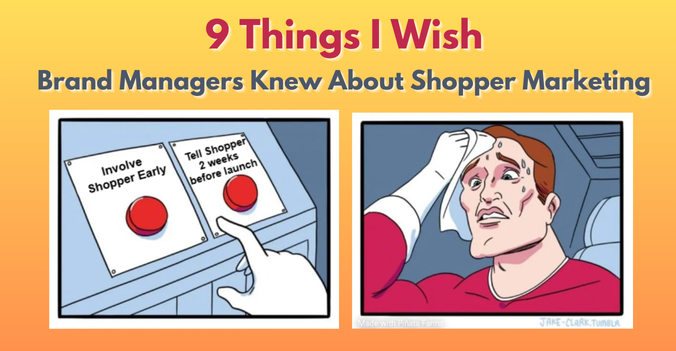
For decades, Excel has been the go-to tool for shopper marketers. Where would shopper marketers be without it?
In a world that is fundamentally changing – where the value of advertising is falling as the value of data rises – the answer to that question has changed.
Has Excel, which was once indispensable, become a liability?
Shopper marketers find themselves between a rock and a hard place: on one hand the path to purchase is becoming increasingly complex and harder to manage manually, on the other, the pressure to keep headcount and reduce non-working dollars is mounting. Most of the CPG enterprise is becoming automated, with CFOs telling their financial departments NOT to use Excel.
Here’s why.
1. Excel Offers Shallow Insight
Most spreadsheets are built to satisfy the needs of specific stakeholders – it’s never the whole story.
Shopper marketers are forced to juggle files for monthly finance reporting, for sharing out program statuses with sales teams, for agency status meetings, for tracking coupon redemptions, for collecting data for post event analysis, for brand share outs, etc.
When shopper marketers are faced with follow-up questions, that jumble of Excel files is useless. There’s no way to immediately drill in or summarize information differently. Instead, each new question turns into hours of work – for an already overburdened department – to gather additional data or re-package data in new ways.
Excel is a tool that makes things harder when it should make things easier.
2. Excel breeds messy data
Multiple team members mean multiple spreadsheets floating around all with varying information and data. If each team member is creating and using their own trackers, this is a recipe for confusion and inconsistency.
It’s a mess.
If all team members pass around and share one Excel file, big mistakes can happen with little accountability. Since so many hands are in one pot, it’s difficult to trace back mistakes or even know if the file has been updated. Sending emails out asking team members where the latest spreadsheet is and if it’s updated is a waste of valuable time.
And if more than one person goes to make edits into the same file at the same time, one of those edits won’t be saved. Or you will have to ask the other person in the file to stop what they are doing and hop out of the file so you can make your edits. Or risk there being multiple files with varying data floating around. Such a headache!
Each marketer also has their own preference when it comes to naming conventions, as well as how they wish to manually roll up to summarize the data. You will spend more time trying to retrace the steps of the file rather than analyzing the data itself.
Excel is a tool that makes things harder when it should make things easier.
3. Excel Relies on Obsolete Information
Shopper marketing world moves too fast for anyone to manually keep up with it. The second you send out a file to stakeholders, the data is already stale. Since you are only displaying a snapshot in time, there is no real time insight ever with Excel.
When it comes to data as a shopper marketer, you want the freshest possible and this is another area where Excel fails you. It does not have the advanced automation capabilities you need to be on the ball of the information and insight rolling in.
You may have to create multiple versions of the master file using the same data to better serve the stakeholders receiving it. After creating file after file, all with similar data all going to various recipients, it’s difficult to keep each one straight and be able to answer questions correctly.
By the time you finish creating and sending all your data files, new data has already rolled in and you will have to start the process all over again.
Excel is a tool that makes things harder when it should make things easier.
4. Bad Excel Data Means Bad Decisions
Spreadsheets are notoriously unreliable when it comes to data quality. Studies show that 88% of spreadsheets contain errors. There are so many things that can go wrong: incorrect formulas, missing data and “fat figer” typos.
A simple mistake in a spreadsheet can be extremely costly. Imagine if you accidentally leave off a zero when entering your shopper marketing program budget for a specific retailer. Instead of allocating $200,000 for Kroger you typed $20,000. Yikes!
Mistakes like that can put you into big trouble with senior leadership and make it appear that you can’t handle the roles and responsibilities of your job.
Excel is a tool that makes things harder when it should make things easier.
5. Excel makes your team look like they are hiding something
Spreadsheets are extremely cumbersome to use when sharing information with core constituents. Shopper marketers suffer as a result of not having simple, consistent, ongoing ways to share their plans with brands, sales and other internal stakeholders.
No wonder shopper marketing is wrongly dismissed as a “black hole” where money goes but little signal comes back from. When you can’t adequately show proof of performance, ROI, and accountability in your reporting, it looks bad. Questions mount. What is the shopper marketing team hiding? Why can’t they give me what I need? Why does their reporting always raise more questions than it answers?
Lack of proper reporting perpetuates the “black hole” narrative — something you do not need and can’t afford.
Excel is a tool that makes things harder when it should make things easier.
The Time Has Come To Look For An Alternative
Let's face it, Excel no longer cuts it, no matter how small your team is or simple your marketing operations are. There are better and more efficient solutions out there.
Invest in real time, collaborative, intelligent systems that will digitize your process, help you implement best practices and automate administrative work. This will eliminate simple (but costly) errors you could be making and streamline your entire workflow, freeing up your time to focus on other essential tasks.
The true cost of using Excel is the opportunity cost of that 50% of your team’s time. Imagine if each of your shopper marketers came up with just one strategic breakthrough idea per year? What would it be worth for your business?
Excel is a tool that makes things harder when it should make things easier.
It’s time to look for a better way.
Other Posts You May Like:
10 SIGNS YOUR SHOPPER MARKETING TEAM OUTGREW EXCEL
ARE YOU STILL BUILDING SHOPPER MARKETING PLANS IN EXCEL?
5 BEST SHOPPER MARKETING COLLABORATION APPS









